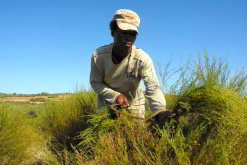
South Africa develops rooibos flavour wheel
by Wilma den Hartigh For those of us who enjoy our daily rooibos cuppa, a good flavour is all-important. However, for the uninitiated it is only possible to distinguish basic flavour characteristics. Now, with the help of a newly developed rooibos flavour wheel, anyone can identify a full spectrum of tastes and aromas of this […]

by Wilma den Hartigh
![[Image]](http://www.mediaclubsouthafrica.com/images/stories/november2010/rooibos1-text.jpg)
Now, with the help of a newly developed rooibos flavour wheel, anyone can identify a full spectrum of tastes and aromas of this uniquely South African – and internationally popular – tea.
The rooibos flavour wheel was developed by a group of South African researchers headed by Stellenbosch University (SU) Masters student Ilona Koch, who worked with Professor Elizabeth Joubert of the Agricultural Research Council and SU lecturer Nina Muller.
“We thought it was time that someone develops a rooibos flavour wheel. We want producers, processors, grading experts, marketers, flavour houses, importers and consumers to all speak the same tea language,” Joubert says.
Koch, who completed a BSc in Food Science at SU, was approached by a lecturer to get involved in the project. “I thought rooibos would be an interesting product to work with,” she says.
The three-year project is jointly funded by the South African Rooibos Council and the Technology and Human Resources for Industry Programme.
![[Image]](http://www.mediaclubsouthafrica.com/images/stories/november2010/rooibos2-text.jpg)
Koch says that the flavour wheel is also important for the industry as many people drink rooibos because of its taste. “I like the taste and I think that this is what draws people to it. It is also not as strong and astringent as black tea,” she says.
The wheel offers 27 descriptive attributes, of which 20 describe the flavour and seven the taste and mouth-feel. Joubert says that just as the wine industry talks about an area’s viticulture terroir, or the sensory attributes of wine in relation to the environmental conditions where grapes grow, so too the growing area affects rooibos flavour nuances.
Diversity of rooibos flavours
According to Koch, the research team carried out numerous experiments on rooibos tea to find out which sensory characteristics are typically associated with its flavour.
The researchers, along with a panel of nine judges, spent a lot of time tasting rooibos tea. Koch says that most of the judges had prior experience with descriptive analysis of numerous products, but analysing the sensory qualities of rooibos tea was a first for them all.
The team studied 69 distinct rooibos samples from 64 plantations in a number of production areas. Selecting samples from different production areas was important as rooibos flavour is influenced by where the crop grows, the soil type, rainfall and weather. Processing also plays a role, as the time taken to process tea leaves can cause the flavour to become watery or sour. “All these factors affect the taste, quality and composition of the tea,” Joubert says.
The selected samples were graded from A to D, representing the highest to the lowest tea quality. “The tasters compiled a long list of the flavours they picked up,” Joubert says. The list was then reduced to the final selection. “We chose those descriptors that were found to be most useful to assess a tea.”
Both negative and positive descriptors were recorded on the wheel. One half contains categories of positive sensory qualities such as sweet, fruity, floral, woody and spicy. Each category lists a few sub-descriptors such as honey, citrus or cinnamon. The negative descriptors are grouped in the same way and contain qualities such as dusty, sour, sweaty and rubbery.
The tea tasting process
It was important that the tasting and tea-brewing process remained scientific and consistent at all times, to ensure that only the most accurate flavour descriptors made it onto the short list. The tea was brewed in 300g of boiling, deionised water, which was poured onto 5.8g of dry tea leaves and infused for five minutes.
Each sample was strained and stored in a stainless steel flask to keep the temperature constant. At each tasting, members of the judging panel sipped 100ml of tea. The tea sample was served in a white porcelain cup and covered with a plastic lid to prevent evaporation and loss of volatiles, also known as aroma compounds. The cups were also preheated to 70º C, and stored in 65º C water baths during the analysis.
The project, which is expected to run until March 2012, will keep the wheel updated with rooibos samples from later seasons. This is important, as even tea produced on the same land can vary in taste from season to season.
“With the flavour wheel, you can pick up the most subtle differences in tea flavour and taste,” says Joubert.
Proven health benefits
The proven health benefits of rooibos (Aspalathus linearis) are encouraging more people to drink the tea. “Consumers are becoming much more aware of healthy lifestyles and rooibos tea is known for its many health benefits,” Koch says.
The tea contains high levels of antioxidants, which help to eliminate damaging free radicals. Recently collaborating scientists from four international research facilities established clinical evidence that drinking rooibos regularly helps the body’s natural defences by enhancing its antioxidant capacity. Both traditional and green rooibos produced this effect.
According to the Rooibos Council, South Africa produces approximately 12 000 tons of rooibos per year. South Africans consume 4 500 to 5 000 tons and the rest is exported.
The growing global demand for rooibos has boosted exports to more than 6 000 tons per annum, and to more than 30 countries worldwide. This includes Germany, The Netherlands, Japan, the UK, and the US, which is the biggest importer of rooibos.